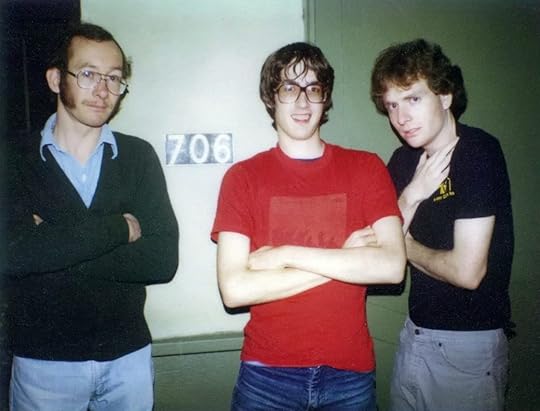Marc Weidenbaum's Blog, page 105
April 17, 2023
“Functional” “Dangerous” “Wedge”
In a Bloomberg opinion piece on AI-generated music, writer Lionel Laurent posits a question: “whether functional music is the thin end of a dangerous wedge.” By “functional music,” Laurent says he means “whale song, white noise, anything designed to play in the background.” By “dangerous” he means an existential threat to non-AI (né human) musicians. By “wedge” he suggests that once AI has conquered this ambient realm, it might threaten what must, by contrast, be considered “foreground music” (my term, not his). This would include hip-hop, rap, pop, country, and anything else that music fans pay (putative) attention to rather than merely play in the background. I use the word “putative” because regular old music has long served as background music. The rise of streaming playlists and the decline of liner notes has already done its fair share of damage to music’s place in the so-called attention economy.
Earlier this week, Anna Nicolaou in the Financial Times cited the same corporate anxiety expressed by the Universal Music Group that Lauren mentions in his article. “The company is asking streaming companies to cut off access to their music catalogue for developers using it to train AI technology,” she wrote. Laurent catches one irony that Nicolaou didn’t note: an album collaboration between James Blake and the music AI firm Endel, Wind Down, was released on the label Republic Records, which happens to be a UMG subsidiary. As Laurent explains: “While Wind Down carries Blake’s name and face, and was mixed from his ingredients — he provided individual ‘stem’ tracks featuring drumbeats and melodies — Endel’s technology generated the final product.”
Then again, that example may be less an irony than it an opportunity to draw a distinction. UMG expresses concern not for a threat on musicians so much as for a threat on the property it manages for musicians. From that vantage, the Blake/Endel team-up isn’t an irony or an anomaly, but a model.
April 16, 2023
Positive Influence
This is the full text of my review, from the March 2023 issue of The Wire, of Stand By for Failure: A Negativland Documentary, directed by Ryan Worsley:

If you know anything about Negativland, then you’ll giggle when you see the FBI warning about copyright infringement at the start of Stand By For Failure, Ryan Worsley’s new documentary film about the band. Few artists have logged as many hours on the battlefield of fair use, let alone questioned as persistently the associated legal constraints around intellectual property, as Negativland, whose sonic, visual and performance appropriations and parodies have challenged eyeballs, eardrums and moral standards alike since the late 1970s. The FBI insignia here feels less like a pro forma admonition, and more like evidence from an active crime scene. And even if you know nothing about Negativland – members of the band debate the extent of their fame in the film – you’ll still have an immediate sense something is up. The FBI warning label is depicted in a sickly green, vibrating as it gets layered below rapidly cycling footage.
Something most definitely is up. Worsley directs her documentary by embracing Negativland’s own “helter stupid” collage techniques. Much of the film layers eviscerated visuals into a vaudevillian media kaleidoscope. Some of this material is drawn from the band’s own work, while other portions simulate the Negativland plunder-drunk ethos, drawing from the group’s favourite resources, such as televangelism, advertising and TV news.
No zone is safe, not even the home that David Wills shared with his mother. We first meet him as a precocious boy when he starts broadcasting his recitation of the weather report in 1959. As he matures, so does home technology. Soon he’s filming and, later, using video recorders to capture daily life. Worsley frequently reproduces segments of Wills’s home movies in split-screen. The message is clear: even the most mundane aspects of human existence are technologically mediated and surveilled – and thus raw material for the madcap minds of Negativland.
Wills befriends other tinkerers and Negativland is born. We see gleeful Mark Hosler and Richard Lyons self-release the group’s first record in 1980. Later member Don Joyce brings a dramaturg’s clarity to their self-awareness. The longtime KPFA DJ says Negativland doesn’t merely copy existing material; their parodic use is antithetical to its initial purpose.
Some sourced interview footage is by William Davenport, who directed an earlier documentary, Media About Media About Media: The Negativland Story. Much is from the members themselves, often filming each other filming something. In one of the film’s many touching moments we see Wills record an emaciated Lyons, who is dying in bed.
Stand By for Failure proceeds chronologically but the antic presentation may confuse those lacking foreknowledge. The story of how Negativland’s song “Christianity Is Stupid” got associated with a murder was a hoax they themselves perpetrated, a point touched on in a manner that could be misunderstood. A U2 parody that nearly cost them everything culminated with Negativland interviewing The Edge – which, again, may elude some viewers. Confusion, of course, comes with the territory. Jon Leidecker aka Wobbly, the group’s most recent member, talks about how when he first heard Negativland at age 15, he thought he had tuned into three radio stations simultaneously.
If you know nothing about Negativland, you may still be confused at the film’s end, but you’ll have another kind of knowledge. Worsley successfully depicts the mix of buffoonery and consciousness-raising that define Negativland. To have told the story straight would have produced the worst sort of parody: unintentional.
April 15, 2023
Scratch Pad: Fog, Sloppiness, Sing-along
I do this manually each Saturday, usually in the morning over coffee: collating most of the little comments I’ve made on social media (as well as related notes), which I think of as my public scratch pad, during the preceding week. These days that mostly means @disquiet@post.lurk.org (on Mastodon). Some material appears here earlier in one form or another.
▰ Wakes wondering why it feels so warm. Then almost immediately hears the foghorn.
▰ Opened a book on collage that I hadn’t since probably 1996, and inside was a bookmark, on which I had written the following in tiny lowercase letters: “beastie boys: doctrinaire in their sloppiness”
▰ If you enjoy hard music, enjoy it while it’s hard, because 20 years later it’s going to be soft; it’s gonna be sing-along time. (Thought while walking to the ocean and back listening to early Battles.)
April 14, 2023
Happy “Avril 14th”
Today is, hands down, one of the dependably best days of the year for electronic music fans. It’s up there with March 3 and August 8 when, respectively, the Roland TB-303 Bass Line and Roland TR-808 Rhythm Composer get their annual shout-outs in the form of fan-friendly social media videos and producer-ready sample packs.
The irony for music fans in the United States is that the hassle of filing one’s taxes each year aligns with a gift that keeps on giving: Aphex Twin’s song “Avril 14th.” The solo instrumental first appeared on the Aphex Twin album Drukqs, released back in 2001. Roughly on its 20th anniversary, back in 2021, Eric Ducker in the New York Times (gift link, no paywall) surveyed the track that had become a quiet phenomenon, noting recordings by Kelly Moran, Alarm Will Sound, and Martin Jacoby, among others, as well as sampling by Kanye West, and the track’s deployment by music supervisors for film.
Each year, musicians of all stripes take stabs at “Avril 14th,” which sounds a bit like if Erik Satie were in an especially sweet mood. While it’s popular with pianists and acoustic guitarists, the instrumentation and arrangements of these covers vary widely. There are countless renditions out there, including Tamara Young on harp, Will Van Horn on pedal steel, and the vibraphone duo of Robby Bowen and Adam Holmes.
In recent weeks, as the eponymous date approached, more versions arrived, including one like an 8-bit video game; an expansive arrangement by Chamomile Crow for celeste, guitar, upright bass, and various synthesizers; Holger Lauritsen on concertina; and Remy van Kesteren on harp.
This activity isn’t unique to YouTube. There’s a Gameboy tracker cover on Instagram and a mbira/kalimba one on TikTok. One of my favorite variations was posted years ago on SoundCloud by Aphex Twin himself: “notes played backwards, not the audio.”
Not surprisingly, music equipment companies have sorted out a means to piggyback on this annual event. Ben Wilson, the prolific YouTube synthesizer personality who goes by the name DivKid, today released an overdubbed rendition of “Avril 14th” on the newly announced Cascadia synthesizer, made by the company Intellijel, which sponsored the video. (I own several pieces of Intellijel equipment, including a case. Good stuff.) That track is just two minutes long. If you have 12 more minutes, you can watch a detailed breakdown by DivKid of the synthesizer patch.
And if that isn’t enough “Avril 14th” for you, you can read my 2021 interview with the classical guitarist Simon Farintosh about his efforts to commit a faithful transcription. As Farintosh noted, the original Drukqs version wasn’t (reportedly) played on a piano, per se: “Richard recorded this song on a Disklavier, a type of mechanised player piano, and there are moments which could challenge even the most competent pianist, if played note-for-note.”
Above I link to numerous different versions. I decided, in the interest of simplicity, to only embed one. This is Stephen Newhouse’s lovely arrangement for music box, which has accrued nearly a quarter of a million views on YouTube in the past dozen years. (Newhouse politely includes a link from his video to someone who had done the same two years prior.)
Archive Dot Urge
Apparently if you live near the Internet Archive, there’s also a mini physical version

April 13, 2023
Disquiet Junto Project 0589: Auto Play

Each Thursday in the Disquiet Junto music community, a new compositional challenge is set before the group’s members, who then have just over four days to upload a track in response to the assignment. Membership in the Junto is open: just join and participate. (A SoundCloud account is helpful but not required.) There’s no pressure to do every project. It’s weekly so that you know it’s there, every Thursday through Monday, when you have the time and interest.
Deadline: This project’s deadline is the end of the day Monday, April 17, 2023, at 11:59pm (that is, just before midnight) wherever you are. It was posted on Thursday, April 13, 2023.
Tracks are added to the SoundCloud playlist for the duration of the project. Additional (non-SoundCloud) tracks appear in the lllllll.co discussion thread.
These following instructions went out to the group’s email list (at tinyletter.com/disquiet-junto).
Disquiet Junto Project 0589: Auto Play
The Assignment: Automate something manual — or vice versa
Step 1: Think about things you’re used to doing when you make music, habits you take for granted.
Step 2: Record a track in which you automate something you usually do manually, or manually do something you usually automate — or both.
This project was inspired by recent conversation in the Disquiet Junto Slack.
Eight Important Steps When Your Track Is Done:
Step 1: Include “disquiet0589” (no spaces or quotation marks) in the name of your tracks.
Step 2: If your audio-hosting platform allows for tags, be sure to also include the project tag “disquiet0589” (no spaces or quotation marks). If you’re posting on SoundCloud in particular, this is essential to subsequent location of tracks for the creation of a project playlist.
Step 3: Upload your tracks. It is helpful but not essential that you use SoundCloud to host your tracks.
Step 4: Post your track in the following discussion thread at llllllll.co:
https://llllllll.co/t/disquiet-junto-project-0589-auto-play/
Step 5: Annotate your track with a brief explanation of your approach and process.
Step 6: If posting on social media, please consider using the hashtag #DisquietJunto so fellow participants are more likely to locate your communication.
Step 7: Then listen to and comment on tracks uploaded by your fellow Disquiet Junto participants.
Step 8: Also join in the discussion on the Disquiet Junto Slack. Send your email address to marc@disquiet.com for Slack inclusion.
Note: Please post one track for this weekly Junto project. If you choose to post more than one, and do so on SoundCloud, please let me know which you’d like added to the playlist. Thanks.
Additional Details:
Length: The length is up to you.
Deadline: This project’s deadline is the end of the day Monday, April 17, 2023, at 11:59pm (that is, just before midnight) wherever you are. It was posted on Thursday, April 13, 2023.
Upload: When participating in this project, be sure to include a description of your process in planning, composing, and recording it. This description is an essential element of the communicative process inherent in the Disquiet Junto. Photos, video, and lists of equipment are always appreciated.
Download: It is always best to set your track as downloadable and allowing for attributed remixing (i.e., a Creative Commons license permitting non-commercial sharing with attribution, allowing for derivatives).
For context, when posting the track online, please be sure to include this following information:
More on this 589th weekly Disquiet Junto project, Auto Play (The Assignment: Automate something manual — or vice versa), at: https://disquiet.com/0589/
About the Disquiet Junto: https://disquiet.com/junto/
Subscribe to project announcements: https://tinyletter.com/disquiet-junto/
Project discussion takes place on llllllll.co: https://llllllll.co/t/disquiet-junto-project-0589-auto-play/
April 12, 2023
Junto Profiles: The First 10
Hundreds of musicians have participated in the Disquiet Junto music community over the years. Each week I send out a composition prompt, and then members from around the world upload a recording of what they make of — or with, or from — it. Back in February I started something I’ve wanted to do for a long time, since not long after the Junto started back in 2012 (almost weekly 600 projects ago, as of this writing). I began interviewing people who contribute regularly. Everyone answers the same questions, and then I ask a follow-up based on their responses. I’ve run one of these Junto Profiles each week since February 6, 2023. At some point I imagine the entries will become less frequent, but I already have several more in the works. Below are the first 10.
Daniel Díaz / From Paris, France: working in film, making space, keeping a notebook
Ian Joyce / From the North Wales coast: soporific synths, having fun, the cat’s meow
xiiixxi / From York, England: growing up with Italian opera, working with Euclidean rhythms
Kei Terauchi Sideboard / From San Francisco, California (and Japan): embracing contradictions, reading to compose
Aethyr / From Sheffield, England: eschewing perfection, tweaking genres
Jason Richardson, aka Bassling / From Leeton, New South Wales, Australia: drafting, redrafting, and collaborating
Klaus-Dieter Hilf, aka RabMusicLab / From Heidelberg, Germany: Mathematics, Munich, MIDI
Joe McMahon, aka Equinox Deschanel / From West Virginia, now SF Bay Area: welcome imperfection, false dichotomies
Michel Banabila / From the Netherlands: “Be open for anything that can happen.”
Mark Rushton / From Des Moines, Iowa: streaming live, and leaving nothing on the shelf
This Week in Sound: Ways of Listening Beyond the Human

These sound-studies highlights of the week originally appeared in the April 11, 2023, issue of the free Disquiet.com weekly email newsletter, This Week in Sound.
▰ BACKING TRACKS: How does music support work activities? Nikki Forrester of Nature spoke with a variety of scientists, including Manuel Gonzalez, an organizational psychologist at Seton Hall University in South Orange, New Jersey: “Gonzalez encourages his lab members to avoid music when delving into new territory, so that they can apply all their mental resources to process what they’re doing and learning. As researchers become more proficient in particular methods, complex tasks can start to feel routine, a better scenario for incorporating music.”
▰ AIR HAZARD: A lizard called the Colorado checkered whiptail deals with noise pollution by stress-eating: “After aircrafts passed, the lizards’ levels of cortisol, a hormone linked to stress, had skyrocketed, the team reports in a paper published last week in the journal Frontiers in Amphibian and Reptile Science,” writes Carolyn Hagler of Smithsonian Magazine. “Their behavior also shifted—the lizards moved around less and ate more in a likely attempt to rebuild the energy resources lost during their stress reaction.”
▰ AUTO PLAY: Wired’s Boone Ashworth profiles Jeremy Yang, lead sound designer for the robovan company Zoox: “Robotaxis have to use a whole suite of noises to guide a rider through the journey and keep them from doing anything stupid along the way. Most of it is standard car stuff: sounds to let you know a door is ajar, sounds to tell you to put your seat belt on, sounds to alert you that the route has changed. The challenge is making the bleeps and bloops communicate as clearly as a human would.”
▰ VEG OUT: More on the sounds of agitated plants, via the New York Times’ Darren Incorvaia: “The vexed vegetables didn’t air their grievances randomly but rather made specific complaints that matched up with the type of stresses they were under. A machine-learning program could correctly tell, with 70 percent accuracy, whether the grumbling plant was thirsty or at risk of decapitation.” (Thanks, Mike Rhode!)
▰ OTHER EARS: Ithaca College hosted a presentation by Kate Galloway on video games that engage with animal perspectives, and how doing so “articulates the complexity of human-animal relationships, displaces the boundaries between human and other, and articulates ways of listening beyond the human to actual and virtual sensory ecologies.”
▰ QUICK NOTES: Growth Market: Noisy incubators could stunt the growth of premature infants (usnews.com). ▰ GPS Whiz: Meet Karen Jacobsen, whose voice is used ubiquitously by Google Maps — and yet which Siri has difficulty recognizing (standardmedia.co.ke). ▰ Ear-ly Adopter: Martha Joseph of the Museum of Modern Art surveyed MOMA’s past engagement with sound art (moma.org/magazine). ▰ On Brand: Wikipedia debuted its new sound logo (fastcompany.com). ▰ Road Rage: Traffic noise makes blood pressure rise (bbc.com).
April 11, 2023
Sound Ledger¹ (FAA, Wilhelm, Plants)
$19,000,000: Amount, in $US, awarded by the Federal Aviation Administration (FAA) to 14 universities to reduce aviation noise
39: Length, in seconds, of the original (and newly rediscovered) recording session that yielded the famed “Wilhelm scream”
40: Average number of “clicks” emitted by “stressed” plants over the course of an hour
. . .
¹Footnotes: FAA: faa.gov. Wilhelm: pastemagazine.com (via John Kannenberg). Plants: gizmodo.com.




